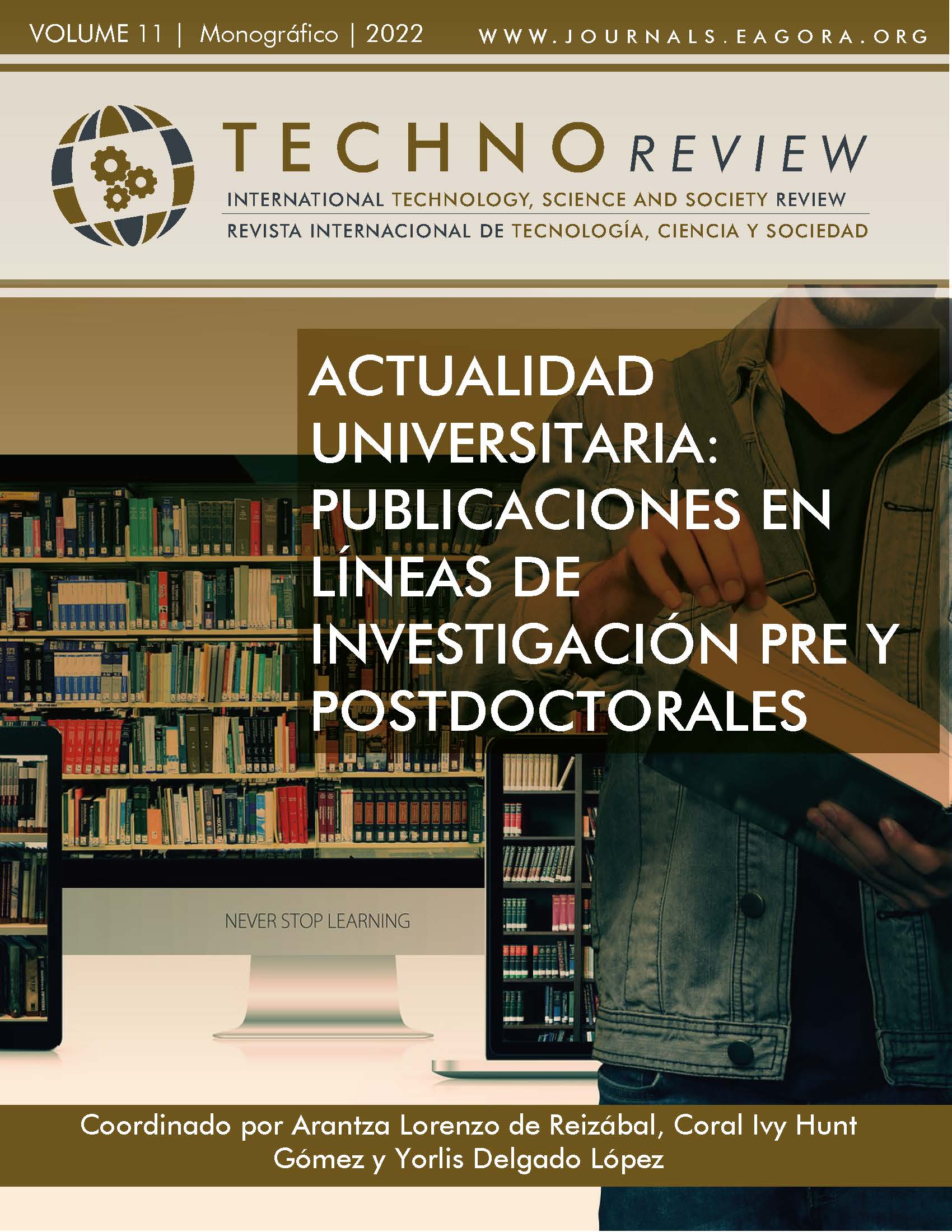Art and Tecnhology. Beyond the normative body
DOI:
https://doi.org/10.37467/revtechno.v11.4442Keywords:
Art, Body, Technology, Transhuman, CiborgAbstract
Throughout history, art has always been linked to the body, as a tool and language, an object of representation, support and concept. It becomes a place, border and field for reflection. An element in constant evolution, marked and transformed by social changes.
Technology, it has also changed the way we relate to and understand our own body, its political identity, genetic evolution, sexuality, the post-human, transhuman, etc. as a search for new conditions that are emphasized within art in new critical and aesthetic actions that confront these notions of non-normative bodies.
References
Antúnez, M. (1999). Requiem [Instalación]. http://www.marceliantunez.com/work/requiem/
Arévalo, L. M.; Gomariz, T. M.; y Suzzi, G. S. (2020). El límite material del representacionalismo en corps étranger de Mona Hatoum. [ponencia]. XII Congreso Internacional de Investigación y Práctica Profesional en Psicología. XXVII Jornadas de Investigación. XVI Encuentro de Investigadores en Psicología del MERCOSUR. II Encuentro de Investigación de Terapia Ocupacional. II Encuentro de Musicoterapia, Facultad de Psicología, Universidad de Buenos Aires. http://doi.org/10.46652/runas.v3i5.57
Baberi, G. (2006). Grey Goo [Acciones en Second Life] Netescopio. http://netescopio.meiac.es/obra.php?id=161
Barreto, R. y Perissinotto, P. (1999). Cyberdance [Net Art]. http://www.satmundi.net/satmundi/dool/a.htm
Beiguelman, G. (2004). //**Code_UP [Proyecto online]. http://netescopio.meiac.es/obra.php?id=90
Biohackinfo News (2018, 8 de noviembre). Transpecies Society presents new cyborgs with novel senses [Notice] Biohackinfo. https://bit.ly/3P5vBO4
Braidotti, R. (2015). Lo posthumano. Gedisa.
Brietbart, H. & Vega, M. (2013, 5 de noviembre). Posthuman: An introduction to Transhumanism [Archivo de video] YouTube. https://youtu.be/bTMS9y8OVuY
Butler, J. (2007). El género en disputa: El feminismo y la subversión de la identidad. Paidós.
Clynes, M. y Kline, N. (1960). Cyborgs and Space. Astronautics, 24-75.
Cuoco, T. (2019). La cabeza prostética de Stelarc hablando sobre Posthumanismo [Archivo de Vídeo] YouTube. https://youtu.be/_58gBVR7ODo
DeepDove: Style Network (2021, 21 de septiembre). Cyborg Art | Transhumanism [CiborgArt].
https://www.cyborgart.org/transhumanism.html
Dekni, J. (2018, 16 de octubre) A new cyborg is born [Performance] Momo. https://bit.ly/3PuCtVg
Dery, M. (1998). Velocidad de escape. La cibercultura en el final del siglo. Ediciones Siruela, Madrid (España). https://core.ac.uk/download/19711227.pdf
Diéguez, A. (2017). Transhumanismo: la búsqueda tecnológica del mejoramiento humano. Herder Editorial.
Doraruma, M. (2016). Corpus Nil [Performance] https://marcodonnarumma.com/works/corpus-nil/
Doepner, S. (2009, 28 de abril). Exoskeleton Performace by Stelarc [Archivo de Vídeo] YouTube. https://youtu.be/R2MntBUwUxY
Franco, C. (2004). El CGAC experimenta con la realidad virtual y las relaciones entre el cuerpo y la robótica. La Voz de Galicia. https://bit.ly/3IG4OWq
Gayozzo, P. (2021). «Biohacking»: el transhumanismo de garaje. Revista Iberoamericana De Bioética, (16), 01-17. https://doi.org/10.14422/rib.i16.y2021.002
Haraway, D. (2020). Manifiesto Ciborg. Kaótica Libros.
Hernández Hernández, F. (2008). “La investigación basada en las artes, propuestas para repensar la investigación en educación”, en Educatio siglo XXI, 208(26), 85-118. http://dx.doi.org/10.5209/aris.69263
Hernández Valencia, J. S. (2019). “¿Vinum novum in utres novos? El postuhumanismo y la ideología de los androids que sueñan con ovejas eléctricas”, en Humanismo y cultura ciudadana. UPB
IDEAL (2022). Active, Activism, Act [Exposición] IDEAL, Centre D’Arts Digitals. https://idealbarcelona.com/es/agenda/active-activism-act/
Lieser, W. (2010). Arte digital: nuevos caminos en el arte. Ullmann.
López-Guzmán, J. A. (2022). “Transespecie: tránsito de los humanos a no humanos”, en Runas: Journal of Education & Culture, 3(5), 1-9. http://doi.org/10.46652/runas.v3i5.57
MDA [Usuario](2022). Maneldeaguas [Página de Instagram] Instagram. https://www.instagram.com/maneldeaguas/?hl=es
Medtronic Diabetes (2019). Guardian™ Sensor 3 - Nuestro sensor más preciso. [Archivo de Vídeo] YouTube. https://youtu.be/6WsUiTyFsQk
Mismag (2022, 4 de marzo). El artista cyborg Kai Landre presenta su nuevo EP: ‘Cyborg’ [Notice] Mixmag. https://bit.ly/3aBsM8B
Muñoz Marín, G. A. y Cifuentes Yarce, J. D. (2021). Humanismo y Transhumanismo: reflexiones desde las ciencias humanas y sociales. Colección Ciencias sociales 18. UPB
Orlan (2016). Entrevista a Orlan en “Híbridos. El cuerpo como imaginario“ [YouTube]. https://youtu.be/Y3egb9DmLqM
Otal, A. (2022, 4 de abril). ‘Eyeborgs’, los humanos que cambian sus ojos por cámaras [Article] Playground. https://bit.ly/3z15rqe
Quimera Rosa (2022). Quimera Rosa [web] https://quimerarosa.net
Ramasseul, D. (2016, 17 de mayo). James Young: ce cyborg a un drone dans le bras [Article] Parismatch. https://bit.ly/3uNChIt
Ramírez, A. (2019, 7 de octubre). Los cíborgs ya están aquí: ingenieros contra filósofos en el fin de los tiempos[Article] El Confidencial. https://bit.ly/3z2q6u6
Ribas, M. (2021). Waiting for Earthquakes en Hables-Gray, C., Figueroa-Sarriera y Mentor, S (Ed.). Modified: Living as a Cyborg. Routledge. https://doi.org/10.4324/9781351107839
Rocha, M. (2009). Apuntes sobre un cuerpo tecno-artistico. Revista DEF-GHI. Comunicación y Arte (2), 1-9.
Scott, R. (Director). (1982). Blade Runner [Película] Warner Bros.
Silva, A. (2016, 12 de septiembre). El cyborg y sus habilidades cibersociales de reproducción virtual: la revolución del cortejo erótico-festivo [Article] WorldNews. https://bit.ly/3z4LleD
Skwarek, M. (2011) AR Occupy Wall Street [Realidad Aumentada]. https://aroccupywallstreet.wordpress.com
Solans, P. (2003). Del espejo a la pantalla: Derivas de la identidad. En Hernández Sánchez, D. Arte, cuerpo y tecnología. Ediciones Universidad de Salamanca.
Stelarc (2000). Visiones parásitas. Revista Fisuras de la cultura contemporánea, 18, 60-78.
Stelarc (2010, 14 de abril). Stomach Sculpture. [Archivo de Vídeo] Youtube. https://youtu.be/IFFizqMmlOQ
Stelarc (2018, 27 de octubre). Stelarc “The Third Hand” 1992 [Archivo de Vídeo] YouTube. https://youtu.be/y3I72ct02iY
Thayer, K.A. (2013). Beyond Cyborg Metapathography in Michael Chorost’s Rebuilt to World Wide Mind: Introducing “morphos” as a rhetorical concept in cyborgography. Revista Teknokultura, Vol. 10 Núm. 2: 415-449. https://dialnet.unirioja.es/descarga/articulo/4820481.pdf
Techbit (2017, 25 de agosto). Humanos mejorados: Cuando los cyborgs se vuelven realidad [Notice] El Universal. https://bit.ly/3AMKJvo
Techbit (2021, 14 de septiembre). La biohacker que quiere ser cyborg y se implantó más de 50 chips. [Notice] El Universal. https://bit.ly/3AOPJzC
Vilodre Goellner, S. & Souza Couto, E. (2007). La estética de los cuerpos mutantes en las obras de Sterlac, Orlan y Gunter von Hagens. Opción, vol. 23, núm. 54, septiembre-diciembre, 2007, pp. 114-131
Warwick, K. (2002). Project Cyborg 2.0. [Web] http://kevinwarwick.coventry.ac.uk/project-cyborg-2-0/
Downloads
Published
Issue
Section
License
All articles are published under an Attribution-NoDerivatives 4.0 International (CC BY-ND 4.0) license. Authors retain copyright over their work.

